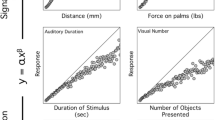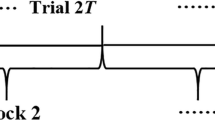Abstract
A general least squares solution for successive intervals is presented, along with iterative procedures for obtaining stimulus scale values, discriminal dispersions, and category boundaries. Because provisions for weighting were incorporated into the derivation, the solution may be applied without loss of rigor to the typical experimental matrix of incomplete data, i.e., to a data matrix with missing entries, as well as to the rarely occurring matrix of complete data. The use of weights also permits adjustments for variations in the reliability of estimates obtained from the data. The computational steps involved in the solution are enumerated, the amount of labor required comparing favorably with other procedures. A quick, yet accurate, graphical approximation suggested by the least squares derivation is also described.
Similar content being viewed by others
References
Attneave, F. A method of graded dichotomies for the scaling of judgments.Psychol. Rev., 1949,56, 334–340.
Bishop, Ruth. Points of neutrality in social attitudes of delinquents and non-delinquents.Psychometrika, 1940,5, 35–45.
Edwards, A. L. The scaling of stimuli by the method of successive intervals.J. appl. Psychol., 1952,36, 118–122.
Finney, D. J. Probit analysis. New York: Cambridge Univer. Press, 1952.
Fisher, R. A. Theory of statistical estimation.Proc. Cam. Phil. Soc., 1925,22, 700–725.
Garner, W. R. and Hake, H. W. The amount of information in absolute judgments.Psychol. Rev., 1951,58, 446–459.
Green, B. F. Attitude measurement. In G. Lindzey (Ed.), Handbook of social psychology. Cambridge, Mass.: Addison-Wesley, 1954.
Guilford, J. P. Psychometric methods. New York: McGraw-Hill, 1936.
Guilford, J. P. The computation of psychological values from judgments in absolute categories.J. exp. Psychol., 1938,22, 32–42.
Gulliksen, H. A least squares solution for successive intervals assuming unequal standard deviations.Psychometrika, 1954,19, 117–139.
Kendall, M. G. The advanced theory of statistics. II. London: Griffin, 1948.
Messick, S., Tucker, L., and Garrison, H. A punched card procedure for the method of successive intervals. Princeton: Educational Testing Service, Research Bulletin 55-25.
Mosier, C. I. A modification of the method of successive intervals.Psychometrika, 1940,5, 101–107.
Rimoldi, H. J. A. and Hormaeche, Marceva. The law of comparative judgment in the successive intervals and graphic rating scale methods. Princeton: Educational Testing Service, Research Bulletin 54-5.
Saffir, M. A comparative study of scales constructed by three psychophysical methods.Psychometrika, 1937,2, 179–198.
Thurstone, L. L. A method of scaling psychological and educational tests.J. educ. Psychol., 1925,16, 433–451.
Thurstone, L. L. A law of comparative judgment.Psychol. Rev., 1927,34, 424–432.
Thurstone, L. L. The unit of measurement in educational scales.J. educ. Psychol., 1927,18, 505–524.
Thurstone, L. L. and Chave, E. J. The measurement of attitude. Chicago: Univer. Chicago Press, 1929.
Torgerson, W. S. A law of categorical judgment. In L. S. Clark (Ed.), Consumer behavior. New York: New York Univer. Press, 1954.
Torgerson, W. S. Theory and method of scaling. Social Science Research Council (to be published).
Tucker, L. R. A level of proficiency scale for a unidimensional skill.Amer. Psychologist, 1952,7, 408 (Abstract).
Author information
Authors and Affiliations
Additional information
This research was jointly supported in part by Princeton University, the Office of Naval Research under contract N6onr-270-20, and the National Science Foundation under grant NSF G-642, and in part by Educational Testing Service.
Rights and permissions
About this article
Cite this article
Diederich, G.W., Messick, S.J. & Tucker, L.R. A general least squares solution for successive intervals. Psychometrika 22, 159–173 (1957). https://doi.org/10.1007/BF02289051
Received:
Revised:
Issue Date:
DOI: https://doi.org/10.1007/BF02289051




